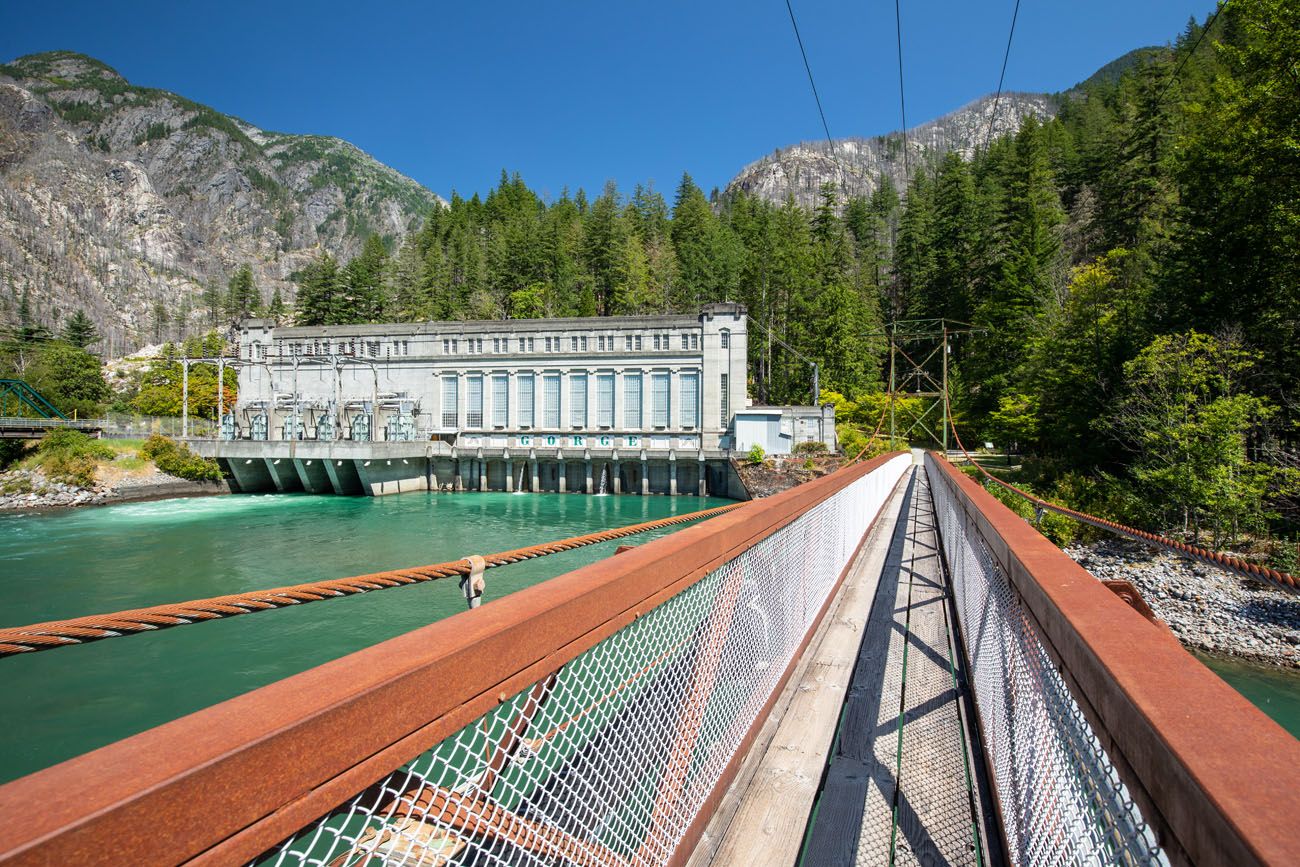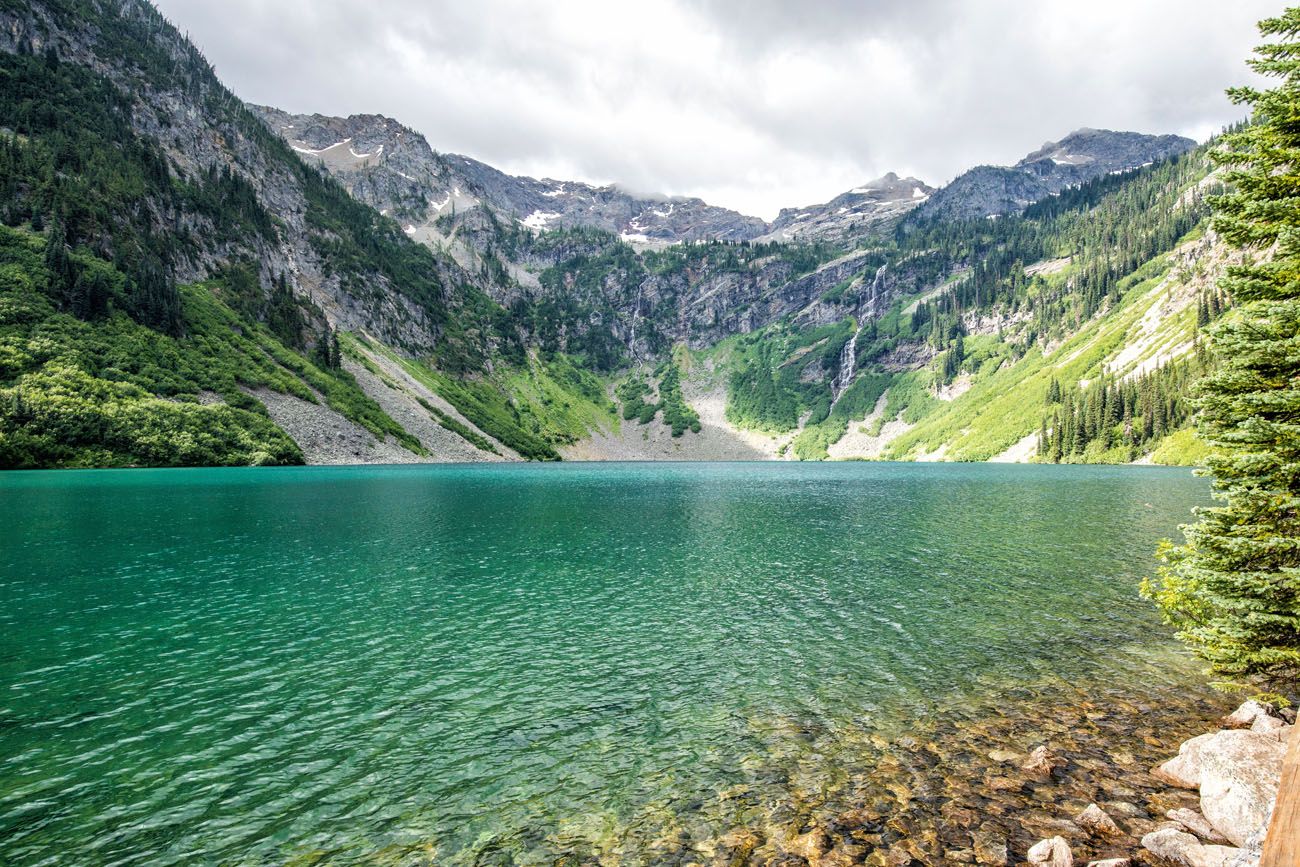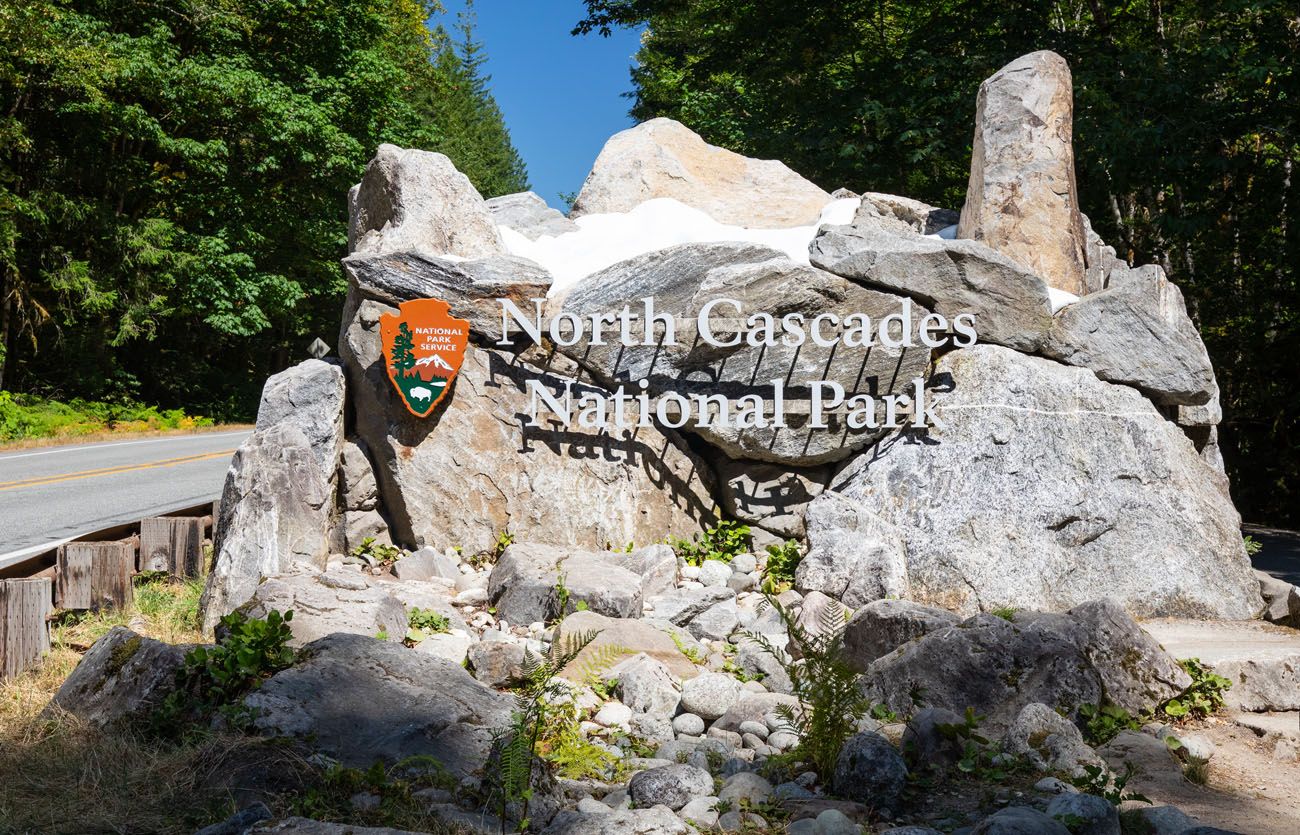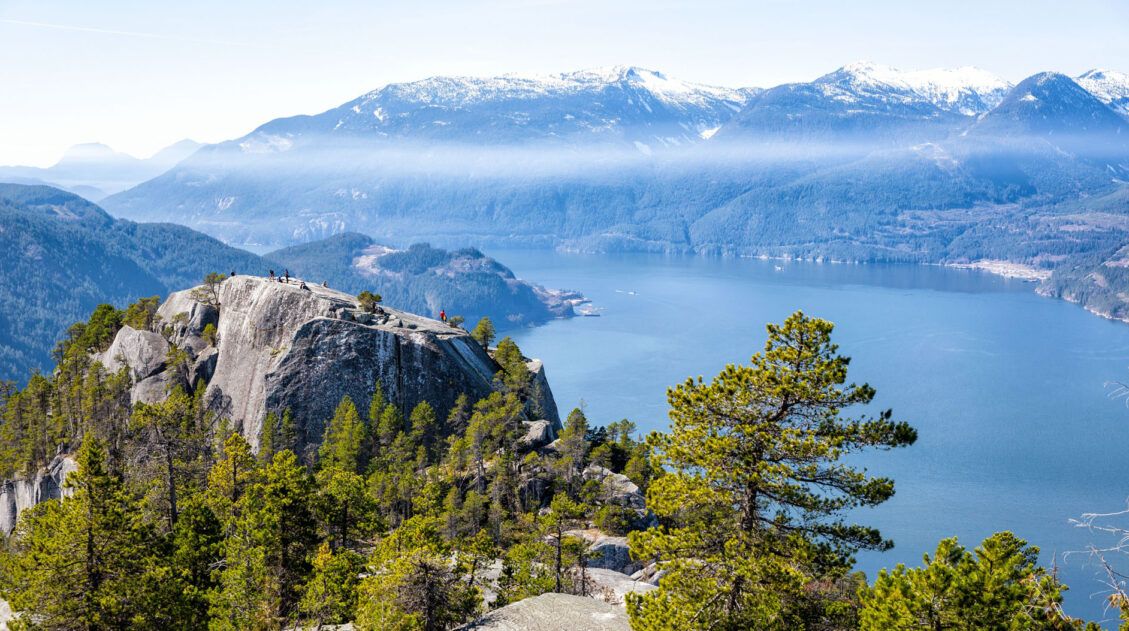Wild, rugged, remote…North Cascades National Park is highly underrated park, especially for hikers and backpackers. The scenic drives and overlooks give you a glimpse of the beauty of this place, but to truly discover the majesty of the North Cascades, you’ll have to hit the hiking trails. Here are the 9 best things to do in North Cascades National Park.
Please practice the seven principles of Leave No Trace: plan ahead, stay on the trail, pack out what you bring to the hiking trail, leave areas as you found them, minimize campfire impacts, be considerate of other hikers, and do not approach or feed wildlife.
A Quick Geography Lesson
North Cascades National Park is located in Washington.
There are three sections to North Cascades National Park Complex: the Chelan Lake National Recreational Area (which includes Stehekin), Ross Lake National Recreational Area, and North Cascades National Park.

There is only one paved road in the park. Highway 20 (also known as North Cascades Highway) runs east west through the park, along the Skagit River, bisecting the park into two pieces. North of this road is Ross Lake. The area along Highway 20 and around Ross Lake is called the Ross Lake National Recreational Area. This is where most visitors spend the majority of their time.
Lake Chelan is in the southeast part of the North Cascades National Park Complex. From Chelan, you can take a boat, plane, or hike to Stehekin, a very small town that is located at the northern end of Lake Chelan. Once in Stehekin, you can go on day hikes or start a backpacking adventure into the interior of the park.
The remainder of the complex is called North Cascades National Park. This includes the area north and south of Highway 20. To get to these regions, you can either drive on one of the dirt roads or go backpacking.
National protected lands lie right outside of the National Park Complex. To the east is the Okanogan National Forest, where you will find beautiful lakes, hiking trails, and the Washington Pass Overlook. To the west is the Mount Baker – Snoqualmie National Forest and the Mount Baker Wilderness. Even though Mount Baker is not tucked away with the national park complex, it still makes a great place to add onto your visit to the North Cascades, as it is a gorgeous place to go hiking in the summer and skiing in the winter.
How to Use This Map: Click the tab in the top left corner of the map to see a list of the points of interest and to turn layers on/off. Click the icons on the map to get more information about each point of interest.
To take this map with you, click the star next to the title of the map which adds it to your Google account. Next, within your Google Maps app, select ‘Saved’ and then select ‘Maps’. This map title will now appear in your list.
Best Things to Do in North Cascades National Park
1. Go for a Scenic Drive on North Cascades Highway
North Cascades Highway (State Highway 20) is the only paved road in the park. It travels east-west along the Skagit River. During the 30 miles the road travels through the park, there are several overlooks, short hikes, and lakes to visit.
2. Sterling Munro Trail
Located at the North Cascades Visitor Center in Newhalem, this 300-foot boardwalk trail takes you to a viewpoint of the Picket Range. This is one of the best places to get views of the jagged, rocky, snow-covered mountain range, unless you plan to hike high into the mountains.

3. Gorge Lake Overlook
From this overlook, you get a view of the Skagit Gorge and the Gorge Dam, a hydroelectric dam. It is a 400-meter walk, round trip, on a paved trail to the overlook. If you like, you can continue another 600 meters along a dirt trail through the woods, for more views of the river, before looping back to the parking lot.

4. Diablo Lake Vista Point
This is our favorite overlook in North Cascades National Park. What a gorgeous view, don’t you think?

Diablo Lake gets its unusual color from the melting glaciers. The glaciers grind against the rocks, forming a powdery silt. The water washes this silt (also called “rock flour”) into the lake, giving it this milky green-blue color.
This overlook is located right on Highway 20. There are several viewpoints located around the large parking lot as well as bathrooms.
5. Ross Lake Overlook
For a view over Ross Lake, make the quick stop at the Ross Lake Overlook. The view isn’t quite as good as it is at the Diablo Lake Overlook, but I still think it is worth the very quick stop.

Off in the distance, you can see Desolation Peak. Jack Kerouac made this peak famous. In 1956, he spent part of the summer here working as a watchman in the fire tower and wrote the book Desolation Angels from this experience. Now, visitors follow in his footsteps, hiking to the top of Desolation Peak.
6. Washington Pass Overlook
This is technically located outside of the North Cascades National Park Complex but it is still well worth the visit. Washington Pass is located on Highway 20, just east of the national park.
From the Washington Pass Overlook, you have an outstanding view of Highway 20 and Liberty Bell Mountain.

Washington Pass

Looking east along Highway 20 from the overlook.
7. Visit Stehekin
Stehekin is a small community located on the far northern end of Lake Chelan. Once here, you can explore Stehekin Valley on foot, go camping, and discover the cultural history of the people who live here. For backpackers, this makes a great starting or ending point for a multi-day hike through the park.
There are no roads to Stehekin. The only way to get here is by boat, plane, or on foot. If you want to visit Stehekin, you will need a minimum of two days, since travel times can be long between Chelan and Stehekin.
Learn more here.
8. Hike the Trails
Without a doubt, one of the best things to do in North Cascades National Park is to go hiking. If you only saw the North Cascades from the viewpoints along Highway 20, you would be missing out on a lot.
You don’t truly get to see the beauty and the grandeur of North Cascades National Park unless you go hiking. If you have the energy and stamina to hike high into the mountains, the views that await you are breathtaking. Layers and layers of glacier-capped mountains stretch off in all directions. It is an awe-inspiring sight.
Listed below are 12 great hikes to do in North Cascades National Park. For detailed information about these hikes, take a look at our Guide to Hiking North Cascades National Park.
Trail of the Cedars Nature Walk: 0.3 miles, flat, easy. This short, easy trail makes a loop alongside the Skagit River. You walk through an old growth forest that faintly resembles the temperate rainforests of Olympic National Park.

Trail of the Cedars
Ladder Creek Falls: 0.4 miles, easy. Just a short walk from the Trail of the Cedars, also located in Newhalem, is Ladder Creek Falls. You will cross a narrow suspension bridge next to the Gorge Powerhouse and then follow the loop trail up to viewpoints of the waterfall.

Suspension bridge to Ladder Creek Falls
Thornton Lake: 10.4 miles, strenuous. This beautiful, remote lake is surrounded by rocky mountains. The trail starts off easy, a relatively flat walk through thick forests. Then the trail climbs steeply up to a ridgeline. After a short descent, you are standing at the shore of Thornton Lake.
Thunder Knob: 3.6 miles, easy to moderate. For beautiful views over Diablo Lake, hike to the top of Thunder Knob. This is a family-friendly trail that starts at Diablo Lake.
Desolation Peak: 9.4 miles, hard. Located on Ross Lake, Desolation Peak offers sweeping views over the park. The trailhead can be reached by crossing Ross Lake by boat or by hiking an additional 16 miles on the East Bank Trail. To get from the lake to Desolation Peak, it is a challenging, steep hike.
Maple Pass Loop: 7.2 miles, moderate to difficult. The Maple Pass Loop offers a little bit of everything…wildflowers, old growth forests, a visit to a lovely alpine lake, and (the best part) panoramic views of the North Cascades. Although it is not located in North Cascades National Park, you bump right up against the park border. From the highest points along the trail, you will have spectacular views of the national park. Get the full details in our guide to the Maple Pass Loop.

Maple Pass Loop Hike
Rainy Lake: 2 miles, easy. This hike shares the same trailhead as the Maple Pass Loop. To get to Rainy Lake, it is a flat walk on a paved trail to a viewpoint of the lake. This is a gorgeous hike and beyond the lake sits North Cascades National Park.

Rainy Lake
Blue Lake: 5 miles, easy to moderate. This is a great to add on to your North Cascades to-do list. It’s short and relatively easy, so it’s perfect for almost all ages and ability levels. The trail ends at the Blue Lake, a brilliantly blue lake that is surrounded by towering mountains.

Blue Lake
Cutthroat Lake: 4 miles, easy. Cutthroat Lake is another lovely lake. To get here, it is a mostly flat walk through a forest. The best part of the hike is crossing the log footbridge just before you reach the lake.

Cutthroat Lake
Cascade Pass and Sahale Arm: 12 miles, hard. Often labeled as the best day hike in North Cascades National Park, the Sahale Arm hike is gorgeous every step of the way. You will hike through evergreen forests, through fields of heather and wildflowers, past marmots, mountain goats, and maybe even bear. Once at the Sahale Glacier Camp, you get to enjoy spectacular views over Doubtful Lake and layers of jagged, snow-capped peaks. Learn more in our Guide to Cascade Pass and Sahale Arm.

The view from Sahale Glacier Camp
Hidden Lake: 9 miles, moderate to strenuous. This hike takes you through alpine meadows and across barren, rocky terrain to a secluded, deep blue lake. Along this hike, you will have stunning views of the North Cascades range, with views of Sahale, Forbidden, and Boston peaks.
Rainbow Loop: 4.4 to 6.8 miles, moderate. This is the most popular hike to do in Stehekin Valley. It is not overly difficult and from the trail, you get to see wonderful views of Stehekin Valley, Lake Chelan, Rainbow Creek, wildflowers, and the surrounding mountains.
12 Great Hikes in North Cascades National Park
A detailed guide to the best hikes in North Cascades National Park.9. Hike a Portion of the Pacific Crest Trail
18 miles of the Pacific Crest Trail travels through North Cascades National Park. The PCT cuts through the narrow sliver of park land, just north of Stehekin. It also travels through the Okanogan National Forest, near Rainy Lake. In order to do this, you will need to obtain a backcountry permit if you plan to camp overnight along the trail. Learn more here.
How Much Time Do You Need in North Cascades National Park?
You need a bare minimum of one full day for North Cascades National Park. Of course, more time is always better.
With one day in North Cascades National Park, drive North Cascades Highway, visit the overlooks, and do one or two hikes. If you prefer short, easy hikes, we recommend Rainy Lake, Blue Lake, or Thunder Knob. For something more challenging that will offer spectacular views of the North Cascades Range, the Maple Pass Loop is amazing.
With two days in North Cascades National Park, do what I list above on day 1. On day 2, you can hike more of the trails along North Cascades Highway or hike to Cascade Pass and/or Sahale Arm. The hike to Sahale Arm and the Glacier Camp is truly spectacular, and in our opinion, the best way to experience this national park, other than going on a backpacking trip.
With three or more days, you can add in more hikes or visit Stehekin.

Hiking the Maple Pass Loop
Where to Stay
Along Highway 20
If you want to stay in the national park along Highway 20, Ross Lake Resort is the only lodge in this area of the park. There are also campgrounds in Newhalem and at Diablo Lake.
East of the North Cascades
There are several small towns to the east of the national park.

Winthrop
Winthrop is a very cool town. It looks like something out of the wild west and it is worth the drive out this way just to see it. Definitely stop into Sherri’s Sweet Shop for some ice cream…the perfect treat after a day of hiking. In Winthrop, River’s Edge Resort, Mt Gardner Inn, and Methow River Lodge all get great reviews.
From Winthrop, it takes one hour to drive to Ross Lake and 40 minutes to drive to Rainy Lake Picnic area.
A little farther down the road from Winthrop is Twisp. This tiny town isn’t as scenic as Winthrop and doesn’t have nearly as many restaurants, but we stayed here and loved it. We stayed at Twisp River Suites in a 2-bedroom apartment. In the evenings, we would get carryout and wine, sit in the river, and have dinner. It was an awesome way to end the day and worth the extra drive time into the park (1 hour 15 minutes to Ross Lake).

The town of Mazama also makes a nice option. It is smaller than Winthrop but it is located closer to the east entrance of the park so you will have a shorter drive. Check out the Mazama Country Inn and the Freestone Inn.
West of the North Cascades
Marblemount is the closest town on the west side of the park. This “town” is made up of a handful of hotels and restaurants. We stayed at the North Cascades Inn. It’s nothing fancy but rooms are clean, quiet, and the WiFi worked well. This makes a great place to stay if you plan to hike Cascade Pass or Hidden Lake, since Cascade River Road starts in this town.
What We Did
We spent three days in the North Cascades as part of a three-week road trip through Washington state. We started on the east side of the park, hiking the trails in Okanogan National Forest, just east of the national park border. On day 2, we hiked the Maple Pass Loop and then drove Highway 20 through the park, stopping at the overlooks mentioned above. We slept in Marblemount and on day 3 hiked Cascade Pass and Sahale Arm.
From North Cascades National Park, we drove north to the Mount Baker area. We only had one full day here and unfortunately, storms moved in, so we could not do any hiking.
This is our itinerary for visiting North Cascades National Park.
Day 1: Arrive in the evening to Twisp. We drove up from Leavenworth, visiting Chelan on the way.
Day 2: Rainy Lake, Blue Lake, Cutthroat Lake, Washington Pass Overlook, afternoon in Winthrop; sleep in Twisp.
Day 3: Maple Pass Loop hike, scenic drive and overlooks on Highway 20; sleep in Marblemount.
Day 4: Cascade Pass and Sahale Arm hike, drive north to Mt. Baker region.

Interesting Facts About North Cascades National Park
The North Cascades Range, for which this park is named, has the largest glacial system in the United States, other than Alaska. In the park, there are over 300 glaciers and 300 lakes. Over millions of years, these glaciers created some of the steepest mountain ranges in the USA, some mountains rising 4,000 to 6,000 feet above their bases.
In the northern area of the park is the Picket Range, a collection of mountains, most rising over 8,000 feet. Somebody had fun naming these mountains: Mount Terror, Phantom Peak, Poltergeist Pinnacle, Mount Fury, and Ghost Peak.
North Cascades National Park is nicknamed the American Alps, getting its name from the jagged, rocky mountain peaks and emerald green slopes.
While visiting the park, keep an eye out for elk, moose, marmots, pika, mountain goats, bighorn sheep, black bear, coyote, lynx, bobcats and otters. Grizzly bear sightings are rare however that may change. Various plans have been proposed to restore grizzly bear populations within North Cascades National Park.
North Cascades is one of the least visited parks in the national park system. In 2023, it only had 40,000 visitors, making it the 7th least visited national park in the United States. North Cascades National Park is a highly underrated park but for those who venture here, it is a peaceful, beautiful experience.

Mountain goat at Sahale Glacier Camp
Plan Your Visit
Entrance Fee: There is no fee to enter North Cascades National Park. Also, there is no entrance booth along Highway 20. However, if you plan to hike in one of the adjacent national forests (such as Rainy Lake or the Maple Pass Loop) you will need a Northwest Forest Pass. This can be purchased for $5 at the trailhead.
Operating Hours: The park is open 365 days a year, but operating hours of the visitor centers vary depending on the season. Road closures are likely during the winter months.
Note: Highway 20 is usually closed between November and April due to snowfall.
Before you go, make sure you get updates about park conditions, road closures, and trail closures on the National Park service website.
If you have any questions about things to do in North Cascades National Park, let us know in the comment section below.
More Information for Your Trip to Washington
If this is part of a bigger road trip through the USA, visit our United States Travel Guide and our Washington Travel Guide for more inspiration and travel planning tips.

















Comments 34